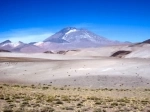Llullaillaco National Park. Antofagasta - CHILE
Direccion:
Region de Antofagasta a 275 km. de la ciudad de Antofagasta The National Park of 268,670 ha, is located 275 km. southeast of the city of Antofagasta, in the Andes of Region II.
Access Routes
Currently access is the most expeditious way to 57 km. which extends along the eastern edge of the mountain range and comes Domeyko the intersection with Route Baquedano-Card.
On the way to the park are observed nitrate plants, mining, salt lakes, extensive grassy plains (bunch grass) that give the landscape its characteristic yellow color.
Tourist Information
The park takes its name from Llullaillaco which, with its 6739 m, height is the second largest in Chile. From its peak dominates the landscape until the Salar de Aguas Calientes. The snowy summit of the volcano contrasts with black lava field located on the southern slope. The park is very densely coexists guanaco and vicu?a, is the only place where they share the same ecological zone.
Llullaillaco Aymara language means "Hot Water" comes from Lloclla (hot) and yacu (water).
Among the most common flora of the park include: Pilaya, papusa water taffy, Walcha, tolilla, Anawa white Cuernecillo, goat horn, verbena, carob fox, baillahu?n, glass cup, straw white, tola. < br>
Among the species of fauna include: vicuna, guanaco, culpeo, eagle, Andean carancho, mining of mountain sickness perdicita drawer cordillerano plover, Sleepyhead monk sleeper of the puna, puna lovebird, field plover, cinclodes cinnamon.
Administration Area:
The Regional Office of the National Forest is located in Avenida Argentina 2510, in the city of Antofagasta, telephone (055) 251364, fax (055) 253669. This office will coordinate the activities relating to the Park.
Special Recommendations:
Tell your visit and return to the police and Park CONAF of the nearest town.
Transite provided by existing official trails
Climbing practices must be coordinated with CONAF personnel and the Army.
The existence of minefields bound to use only official road vehicle and pedestrian trails well marked.
Visit the Park accompanied
Bring water and food that provides abundant calories
Remember that you are responsible for their own safety within the Park
Do not leave traces of your visit to this park
For much of the year the days are clear, so high radiation is suggested to use light clothing, including hats and sunglasses. However, after sunset the temperature drops quickly and so well that sometimes it is desirable to have warm clothes.
During the colder months is advisable to wear warm clothes even during daylight hours, because they tend to run winds of variable intensity but low temperature, even on sunny days.




